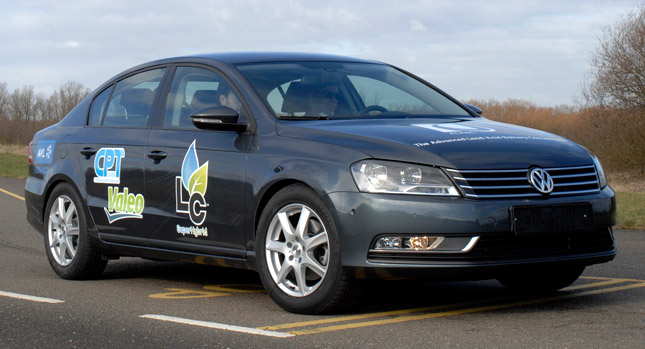Zero emission vehicles are as “green” as you can get, but fuel cells are still a long way from mass production and EVs’ limited range and high prices are a deterrent for a large percentage of new car buyers. Hybrids, while more affordable, still command a higher price than regular models.
And here’s where UK-based Controlled Power Technologies (CPT) and U.S. Advanced Lead-Acid Battery Consortium (ALABC) come into the picture.
The two companies have teamed up to develop the LC Super Hybrid, which is a new technology that promises to lower a gasoline engine’s consumption to levels comparable to a diesel, but at a much lower cost that a traditional hybrid.
A European-market VW Passat with a 1.4-liter TSI engine has been used as the demonstrator that will be displayed at the Geneva Motor Show.
The LC Super Hybrid comprises an electric supercharger, a next-generation belt-integrated starter generator, carbon enhanced valve regulated lead-acid batteries that do away with the need for a super-capacitor and higher gearbox ratios for reduced engine speed.
The entire package adds just 79 kg (174 lb) to the weight of the car, although this figure includes testing equipment fitted to the prototype, so it will actually be lighter in production trim.
The “micro-mild” Passat demonstrator has an output of 142PS (140hp) and 275Nm of torque, up from the standard engine’s 122PS (120hp) and 200Nm, rivaling the performance of normally aspirated 2.0-liter cars.
Yet it emits less than 130 g/km of CO2, which is 10 g/km less than the already best-in-class figure of the standard Passat 1.4 TSI – and 23 percent less than the comparable 1.8-liter Passat TSI.
“We are confident we have met the challenge facing the automotive industry for cost efficient CO2 reduction technology, compatible with legislative demands and at showroom prices that consumers are willing and able to afford”, said ALABC European projects coordinator Allan Cooper. “There is no huge upfront cost with this technology and therefore no need for expensive subsidies from the taxpayer.”
According to the manufacturer, the next-generation lead-carbon batteries used by the LC Super Hybrid have “excellent charge and discharge characteristics” and, thanks to careful management, improved battery life.
CPT and ALABC estimate that the “micro-mild” hybrid technology, which is production-ready, will cost car manufacturers an additional €750-1,500 (US$1,000-2,000) per car, with the 48-volt version offering more than 25 percent reduction in CO2 emissions compared to a gasoline 2.0-liter engine.
High-voltage hybrids, which reduce CO2 emissions by 15-20 percent, add €3,000-5,000 (US$4,000-6,700) to manufacturing costs. Plug-in electric hybrids, which reduce CO2 emissions by more than 20 percent, cost significantly more at €6,000-10,000 (US$8,000-13,300).
This is due to the high cost of lithium-ion and nickel-hybrid batteries, hence the need for government subsidies in order to make those vehicles more accessible to consumers.
PHOTO GALLERY















